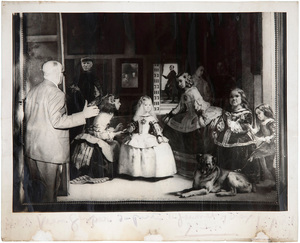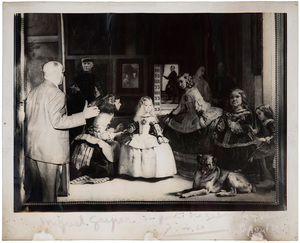Pablo Picasso; Reinterpreting the myth.
The Antonio Orzaez collection has three of Pablo Picasso’s most personal and revealing works. A collage from 1957 and two photomontages resulting from the series “Variaciones de las Meninas” which was an arduous research work that Picasso carried out in the 1950s. In this series, the artist from Malaga not only reinterprets the work of Velázquez, but also supplants the role of the baroque painter, imposing himself on his figure and consolidating himself as the great contemporary master of the history of Spanish art, being a meritorious heir to the pictorial tradition of the country.
Picasso’s relationship with Velázquez, his passion and obsession with the Sevillian painter began in childhood. The first time that Picasso was able to contemplate the works of Velázquez was when he was thirteen years old, when he visited the Prado Museum with his father. Years later, when he was studying at the San Fernando School of Fine Arts, in 1897, he signed up as a copyist for the Prado Museum, choosing among the works to replicate various paintings by Velázquez; The portrait of Felipe IV and a note of Las Meninas. But with the passage of time and the evolution of the artist from Malaga, the relationship between Picasso and Velázquez ceased to be that of an apprentice and his teacher. Admiration was transformed into a competitiveness that went beyond the mere exercise of technique and alluded to emotional values. During the Civil War Picasso, as honorary director of the Prado Museum, was one of the few people who was able to see the Meninas in Geneva, where they had been transferred, to prevent the war from destroying them. There face to face with the work, Picasso contemplated the precise and daring brushstrokes of an artist who was no longer his teacher but his equal.
The idea of Las Meninas was impregnated in the mind of the artist, who in 1950 transmitted to his friend Sabartés “If someone started to copy Las Meninas, totally in good faith, at a certain point and if the one who copied them was me, I would say: What if I put this one a little more to the right or to the left? I would try to do it my way, forgetting Velázquez. The test would surely lead me to modify the light or to change it, on the occasion of having changed a character’s place. Thus, little by little, I would paint some Meninas that would be detestable for the professional copyist, but they would be my Meninas”.
Years later, at his estate La Californie (Cannes), Picasso set up a new studio and shut himself away for four months with the intention of reinterpreting Las Meninas, transferring the myth to the contemporary, contributing the plastic values of the avant-garde. The whole process was documented by his faithful friend Sabartés, in his book “Las Meninas et la vie”. The collection consists of forty-five interpretations of the work, nine scenes of a dovecote, three landscapes and a portrait of Jacqueline, to which are added various montages such as the works that are tendered in Setdart. One of the versions of this photomontage was collected in the keynote speech by Elisabeth Cowling “Jaume Sabartes Seen by Pablo Picasso” held at the Pablo Picasso Museum in Barcelona in March 2014, in which Cowling explains how Picasso supplants the identity of Velázquez, while Sabartés occupies the place of valet, as the king’s squire. The total set of variations was exhibited at the Picasso Museum in Barcelona in 2015, where Picasso had donated the entire collection of his Meninas, as a tribute to his friend Sabartés, who died in 1968.







